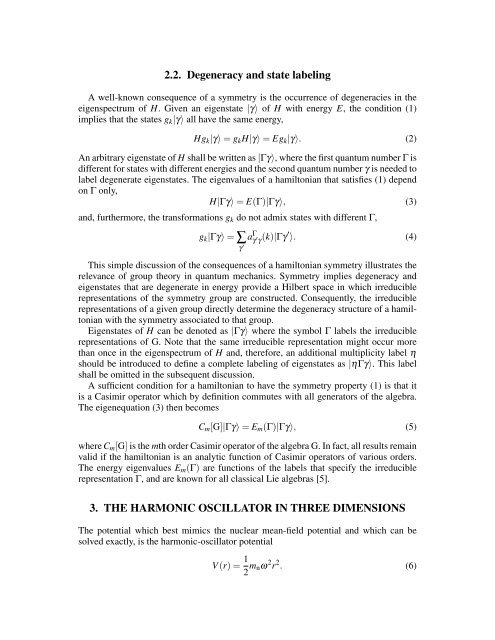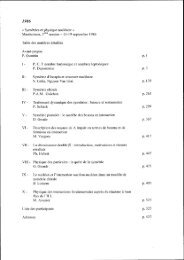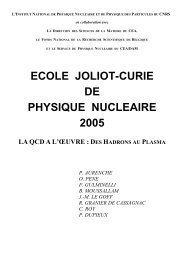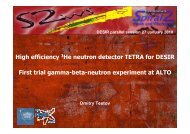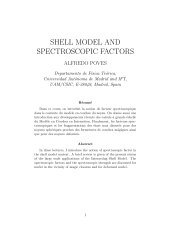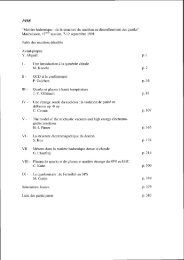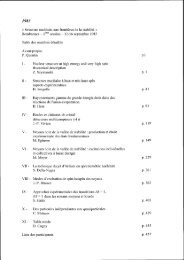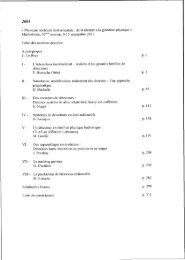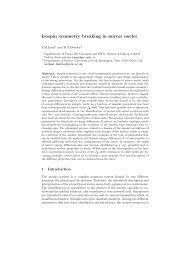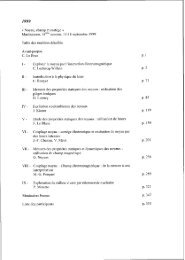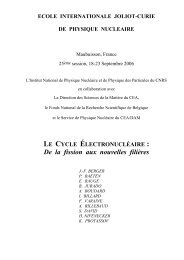SYMMETRIES IN NUCLEI - Cenbg - IN2P3
SYMMETRIES IN NUCLEI - Cenbg - IN2P3
SYMMETRIES IN NUCLEI - Cenbg - IN2P3
Create successful ePaper yourself
Turn your PDF publications into a flip-book with our unique Google optimized e-Paper software.
2.2. Degeneracy and state labelingA well-known consequence of a symmetry is the occurrence of degeneracies in theeigenspectrum of H. Given an eigenstate |γ〉 of H with energy E, the condition (1)implies that the states g k |γ〉 all have the same energy,Hg k |γ〉 = g k H|γ〉 = Eg k |γ〉. (2)An arbitrary eigenstate of H shall be written as |Γγ〉, where the first quantum number Γ isdifferent for states with different energies and the second quantum number γ is needed tolabel degenerate eigenstates. The eigenvalues of a hamiltonian that satisfies (1) dependon Γ only,H|Γγ〉 = E(Γ)|Γγ〉, (3)and, furthermore, the transformations g k do not admix states with different Γ,g k |Γγ〉 = ∑γ ′ a Γ γ ′ γ (k)|Γγ′ 〉. (4)This simple discussion of the consequences of a hamiltonian symmetry illustrates therelevance of group theory in quantum mechanics. Symmetry implies degeneracy andeigenstates that are degenerate in energy provide a Hilbert space in which irreduciblerepresentations of the symmetry group are constructed. Consequently, the irreduciblerepresentations of a given group directly determine the degeneracy structure of a hamiltonianwith the symmetry associated to that group.Eigenstates of H can be denoted as |Γγ〉 where the symbol Γ labels the irreduciblerepresentations of G. Note that the same irreducible representation might occur morethan once in the eigenspectrum of H and, therefore, an additional multiplicity label ηshould be introduced to define a complete labeling of eigenstates as |ηΓγ〉. This labelshall be omitted in the subsequent discussion.A sufficient condition for a hamiltonian to have the symmetry property (1) is that itis a Casimir operator which by definition commutes with all generators of the algebra.The eigenequation (3) then becomesC m [G]|Γγ〉 = E m (Γ)|Γγ〉, (5)where C m [G] is the mth order Casimir operator of the algebra G. In fact, all results remainvalid if the hamiltonian is an analytic function of Casimir operators of various orders.The energy eigenvalues E m (Γ) are functions of the labels that specify the irreduciblerepresentation Γ, and are known for all classical Lie algebras [5].3. THE HARMONIC OSCILLATOR <strong>IN</strong> THREE DIMENSIONSThe potential which best mimics the nuclear mean-field potential and which can besolved exactly, is the harmonic-oscillator potentialV (r) = 1 2 m nω 2 r 2 . (6)


